Identification of MiRNA–Disease Associations Based on Information of Multi-Module and Meta-Path
Abstract
1. Introduction
- 1.
- Protein information and meta-path strategy were utilized to construct the multi-module, which can enrich the information of miRNAs and diseases.
- 2.
- The topological and semantic information can be better learned by Graph attention network and attention mechanism.
- 3.
- A reliable negative sample selection strategy was utilized to overcome the imbalance between positive and negative samples.
2. Results
2.1. Dimension Optimization of Node Representation
2.2. Classifier Optimization
2.3. Comparison with Other Methods
2.4. Proportion of Negative Sample
2.5. Reliability of Negative Sample
2.6. Case Studies
3. Discussion
4. Materials and Methods
4.1. Integration Similarity Calculation and Multi-Module Construction
4.1.1. MiRNA Integration Similarity
4.1.2. Disease Integration Similarity
4.1.3. Multi Module Construction
4.2. Information Aggregation
4.2.1. Node Feature Linear Transformation and Aggregation
4.2.2. Module Aggregation
4.2.3. Training and Prediction
4.3. Model Experiment and Evaluation
5. Conclusions
Author Contributions
Funding
Institutional Review Board Statement
Informed Consent Statement
Data Availability Statement
Conflicts of Interest
Sample Availability
References
- Berindan-Neagoe, I.; Monroig, P.d.C.; Pasculli, B.; Calin, G.A. MicroRNAome genome: A treasure for cancer diagnosis and therapy. CA Cancer J. Clin. 2014, 64, 311–336. [Google Scholar] [CrossRef] [PubMed]
- Ambros, V. MicroRNAs: Tiny regulators with great potential. Cell 2001, 107, 823–826. [Google Scholar] [CrossRef]
- Bartel, D.P. MicroRNAs: Genomics, biogenesis, mechanism, and function. Cell 2004, 116, 281–297. [Google Scholar] [CrossRef]
- Ambros, V. The functions of animal microRNAs. Nature 2004, 431, 350–355. [Google Scholar] [CrossRef]
- Friedman, R.C.; Farh, K.K.-H.; Burge, C.B.; Bartel, D.P. Most mammalian mRNAs are conserved targets of microRNAs. Genome Res. 2009, 19, 92–105. [Google Scholar] [CrossRef] [PubMed]
- Ha, M.; Kim, V.N. Regulation of microRNA biogenesis. Nat. Rev. Mol. Cell. Biol. 2014, 15, 509–524. [Google Scholar] [CrossRef] [PubMed]
- Hua, S.; Yun, W.; Zhiqiang, Z.; Zou, Q. A discussion of micrornas in cancers. Curr. Bioinform. 2014, 9, 453–462. [Google Scholar] [CrossRef]
- Das, J.; Podder, S.; Ghosh, T.C. Insights into the miRNA regulations in human disease genes. BMC Genom. 2014, 15, 1010. [Google Scholar] [CrossRef]
- Santamaria, X.; Taylor, H. MicroRNA and gynecological reproductive diseases. Fertil. Steril. 2014, 101, 1545–1551. [Google Scholar] [CrossRef]
- Condorelli, G.; Latronico, M.V.; Cavarretta, E. MicroRNAs in cardiovascular diseases: Current knowledge and the road ahead. J. Am. Coll. Cardiol. 2014, 63, 2177–2187. [Google Scholar] [CrossRef]
- Gong, H.; Liu, C.M.; Liu, D.P.; Liang, C.C. The role of small RNAs in human diseases: Potential troublemaker and therapeutic tools. Med. Res. Rev. 2005, 25, 361–381. [Google Scholar] [CrossRef]
- Dimić, D.S.; Kaluđerović, G.N.; Avdović, E.H.; Milenković, D.A.; Živanović, M.N.; Potočňák, I.; Samoľová, E.; Dimitrijević, M.S.; Saso, L.; Marković, Z.S.; et al. Synthesis, Crystallographic, quantum chemical, antitumor, and molecular docking/dynamic studies of 4-hydroxycoumarin-neurotransmitter derivatives. Int. J. Mol. Sci. 2022, 23, 1001. [Google Scholar] [CrossRef]
- Wang, S.-H.; Govindaraj, V.V.; Górriz, J.M.; Zhang, X.; Zhang, Y.-D. COVID-19 classification by FGCNet with deep feature fusion from graph convolutional network and convolutional neural network. Inf. Fusion 2021, 67, 208–229. [Google Scholar] [CrossRef] [PubMed]
- Li, Z.; Wang, Y.; Xie, Y.; Zhang, L.; Dai, Z.; Zou, X. Predicting the binding affinities of compound-protein interactions by random forest using network topology features. Anal. Methods 2018, 10, 4152–4161. [Google Scholar] [CrossRef]
- Jiang, Q.; Hao, Y.; Wang, G.; Juan, L.; Zhang, T.; Teng, M.; Liu, Y.; Wang, Y. Prioritization of disease microRNAs through a human phenome-microRNAome network. BMC Syst. Biol. 2010, 4, S2. [Google Scholar] [CrossRef] [PubMed]
- Chen, X.; Yan, C.C.; Zhang, X.; You, Z.H.; Deng, L.; Liu, Y.; Zhang, Y.; Dai, Q. WBSMDA: Within and between Score for MiRNA-Disease Association prediction. Sci. Rep. 2016, 6, 21106. [Google Scholar] [CrossRef] [PubMed]
- Pasquier, C.; Gardès, J. Prediction of miRNA-disease associations with a vector space model. Sci. Rep. 2016, 6, 27036. [Google Scholar] [CrossRef]
- Chen, X.; Liu, M.X.; Yan, G.Y. RWRMDA: Predicting novel human microRNA-disease associations. Mol. Biosyst. 2012, 8, 2792–2798. [Google Scholar] [CrossRef]
- Xuan, P.; Han, K.; Guo, Y.; Li, J.; Li, X.; Zhong, Y.; Zhang, Z.; Ding, J. Prediction of potential disease-associated microRNAs based on random walk. Bioinformatics 2015, 31, 1805–1815. [Google Scholar] [CrossRef]
- You, Z.-H.; Huang, Z.-A.; Zhu, Z.; Yan, G.-Y.; Li, Z.-W.; Wen, Z.; Chen, X. PBMDA: A novel and effective path-based computational model for miRNA-disease association prediction. PLoS Comput. Biol. 2017, 13, e1005455. [Google Scholar] [CrossRef]
- Chen, M.; Liao, B.; Li, Z. Global similarity method based on a two-tier random walk for the prediction of microRNA-disease association. Sci. Rep. 2018, 8, 6481. [Google Scholar] [CrossRef] [PubMed]
- Hussain, I.; Hossain, M.A.; Jany, R.; Bari, M.A.; Uddin, M.; Kamal, A.R.M.; Ku, Y.; Kim, J.-S. Quantitative Evaluation of EEG-Biomarkers for Prediction of Sleep Stages. Sensors 2022, 22, 3079. [Google Scholar] [CrossRef] [PubMed]
- Hussain, I.; Park, S.J. HealthSOS: Real-time health monitoring system for stroke prognostics. IEEE Access 2020, 8, 213574–213586. [Google Scholar] [CrossRef]
- Gao, Z.; Liu, X.; Qi, S.; Wu, W.; Hau, W.K.; Zhang, H. Automatic segmentation of coronary tree in CT angiography images. Int. J. Adapt. Control. Signal Process. 2019, 33, 1239–1247. [Google Scholar] [CrossRef]
- Jiang, Q.; Wang, G.; Jin, S.; Li, Y.; Wang, Y. Predicting human microRNA-disease associations based on support vector machine. Int. J. Data Min. Bioinform. 2013, 8, 282–293. [Google Scholar] [CrossRef]
- Zhao, Y.; Chen, X.; Yin, J. Adaptive boosting-based computational model for predicting potential miRNA-disease associations. Bioinformatics 2019, 35, 4730–4738. [Google Scholar] [CrossRef]
- Li, J.; Zhang, S.; Liu, T.; Ning, C.; Zhang, Z.; Zhou, W. Neural inductive matrix completion with graph convolutional networks for miRNA-disease association prediction. Bioinformatics 2020, 36, 2538–2546. [Google Scholar] [CrossRef]
- Xuan, P.; Sun, H.; Wang, X.; Zhang, T.; Pan, S. Inferring the Disease-Associated miRNAs Based on Network Representation Learning and Convolutional Neural Networks. Int. J. Mol. Sci. 2019, 20, 3648. [Google Scholar] [CrossRef]
- Ji, C.; Gao, Z.; Ma, X.; Wu, Q.; Ni, J.; Zheng, C. AEMDA: Inferring miRNA-disease associations based on deep autoencoder. Bioinformatics 2021, 37, 66–72. [Google Scholar] [CrossRef]
- Jin, S.; Zeng, X.; Xia, F.; Huang, W.; Liu, X. Application of deep learning methods in biological networks. Brief. Bioinform. 2021, 22, 1902–1917. [Google Scholar] [CrossRef]
- Zhao, T.; Hu, Y.; Cheng, L. Deep-DRM: A computational method for identifying disease-related metabolites based on graph deep learning approaches. Brief. Bioinform. 2021, 22, bbaa212. [Google Scholar] [CrossRef]
- Sun, M.; Zhao, S.; Gilvary, C.; Elemento, O.; Zhou, J.; Wang, F. Graph convolutional networks for computational drug development and discovery. Brief. Bioinform. 2020, 21, 919–935. [Google Scholar] [CrossRef]
- Yue, X.; Wang, Z.; Huang, J.; Parthasarathy, S.; Moosavinasab, S.; Huang, Y.; Lin, S.M.; Zhang, W.; Zhang, P.; Sun, H. Graph embedding on biomedical networks: Methods, applications and evaluations. Bioinformatics 2020, 36, 1241–1251. [Google Scholar] [CrossRef]
- Kipf, T.N.; Welling, M. Semi-supervised classification with graph convolutional networks. arXiv preprint 2016, arXiv:1609.02907. [Google Scholar]
- Veličković, P.; Cucurull, G.; Casanova, A.; Romero, A.; Lio, P.; Bengio, Y. Graph attention networks. arXiv preprint 2017, arXiv:1710.10903. [Google Scholar]
- Wang, X.; Ji, H.; Shi, C.; Wang, B.; Ye, Y.; Cui, P.; Yu, P.S. Heterogeneous graph attention network. In Proceedings of the 26th International World Wide Web Conference, San Francisco, CA, USA, 13–17 May 2019; pp. 2022–2032. [Google Scholar]
- Xie, G.; Fan, Z.; Sun, Y.; Wu, C.; Ma, L. WBNPMD: Weighted bipartite network projection for microRNA-disease association prediction. J. Transl. Med. 2019, 17, 322. [Google Scholar] [CrossRef]
- Yan, C.; Wang, J.; Ni, P.; Lan, W.; Wu, F.-X.; Pan, Y. DNRLMF-MDA: Predicting microRNA-disease associations based on similarities of microRNAs and diseases. IEEE/ACM Trans. Comput. Biol. Bioinform. 2017, 16, 233–243. [Google Scholar] [CrossRef]
- Ding, Y.; Tian, L.-P.; Lei, X.; Liao, B.; Wu, F.-X. Variational graph auto-encoders for miRNA-disease association prediction. Methods 2021, 192, 25–34. [Google Scholar] [CrossRef]
- Yang, Z.; Wu, L.; Wang, A.; Tang, W.; Zhao, Y.; Zhao, H.; Teschendorff, A.E. dbDEMC 2.0: Updated database of differentially expressed miRNAs in human cancers. Nucleic Acids Res. 2017, 45, D812–D818. [Google Scholar] [CrossRef]
- Mohammadian, M.; Mahdavifar, N.; Mohammadian-Hafshejani, A.; Salehiniya, H. Liver cancer in the world: Epidemiology, incidence, mortality and risk factors. World Cancer Res. J. 2018, 5, 8. [Google Scholar]
- El-Serag, H.B.; Rudolph, K.L. Hepatocellular carcinoma: Epidemiology and molecular carcinogenesis. Gastroenterology 2007, 132, 2557–2576. [Google Scholar] [CrossRef]
- Pineau, P.; Volinia, S.; McJunkin, K.; Marchio, A.; Battiston, C.; Terris, B.; Mazzaferro, V.; Lowe, S.W.; Croce, C.M.; Dejean, A. miR-221 overexpression contributes to liver tumorigenesis. Proc. Natl. Acad. Sci. USA 2010, 107, 264–269. [Google Scholar] [CrossRef]
- Han, Z.-B.; Chen, H.-Y.; Fan, J.-W.; Wu, J.-Y.; Tang, H.-M.; Peng, Z.-H. Up-regulation of microRNA-155 promotes cancer cell invasion and predicts poor survival of hepatocellular carcinoma following liver transplantation. J. Cancer Res. Clin. Oncol. 2012, 138, 153–161. [Google Scholar] [CrossRef]
- Inamura, K. Lung cancer: Understanding its molecular pathology and the 2015 WHO classification. Front. Oncol. 2017, 7, 193. [Google Scholar] [CrossRef]
- Fan, L.; Qi, H.; Teng, J.; Su, B.; Chen, H.; Wang, C.; Xia, Q. Identification of serum miRNAs by nano-quantum dots microarray as diagnostic biomarkers for early detection of non-small cell lung cancer. Tumor Biol. 2016, 37, 7777–7784. [Google Scholar] [CrossRef]
- Zhang, H.; Mao, F.; Shen, T.; Luo, Q.; Ding, Z.; Qian, L.; Huang, J. Plasma miR-145, miR-20a, miR-21 and miR-223 as novel biomarkers for screening early-stage non-small cell lung cancer. Oncol. Lett. 2017, 13, 669–676. [Google Scholar] [CrossRef]
- Florean, C.; Schnekenburger, M.; Grandjenette, C.; Dicato, M.; Diederich, M. Epigenomics of leukemia: From mechanisms to therapeutic applications. Epigenomics 2011, 3, 581–609. [Google Scholar] [CrossRef]
- Ning, F.; Zhou, Q.; Chen, X. miR-200b promotes cell proliferation and invasion in t-cell acute Lymphoblastic leukemia through NOTCH1. J. Biol. Regul. Homeost. Agents 2018, 32, 1467–1471. [Google Scholar]
- Sanghvi, V.R.; Mavrakis, K.J.; Van der Meulen, J.; Boice, M.; Wolfe, A.L.; Carty, M.; Mohan, P.; Rondou, P.; Socci, N.D.; Benoit, Y. Characterization of a set of tumor suppressor microRNAs in T cell acute lymphoblastic leukemia. Sci. Signal. 2014, 7, ra111. [Google Scholar] [CrossRef]
- Xiao, Y.; Su, C.; Deng, T. miR-223 decreases cell proliferation and enhances cell apoptosis in acute myeloid leukemia via targeting FBXW7. Oncol. Lett. 2016, 12, 3531–3536. [Google Scholar] [CrossRef]
- Li, Y.; Qiu, C.; Tu, J.; Geng, B.; Yang, J.; Jiang, T.; Cui, Q. HMDD v2.0: A database for experimentally supported human microRNA and disease associations. Nucleic Acids Res. 2014, 42, D1070–D1074. [Google Scholar] [CrossRef]
- Davis, A.P.; Grondin, C.J.; Johnson, R.J.; Sciaky, D.; Wiegers, J.; Wiegers, T.C.; Mattingly, C.J. Comparative toxicogenomics database (CTD): Update 2021. Nucleic Acids Res. 2021, 49, D1138–D1143. [Google Scholar] [CrossRef]
- Hsu, S.-D.; Lin, F.-M.; Wu, W.-Y.; Liang, C.; Huang, W.-C.; Chan, W.-L.; Tsai, W.-T.; Chen, G.-Z.; Lee, C.-J.; Chiu, C.-M. miRTarBase: A database curates experimentally validated microRNA-target interactions. Nucleic Acids Res. 2011, 39, D163–D169. [Google Scholar] [CrossRef]
- Van Laarhoven, T.; Nabuurs, S.B.; Marchiori, E. Gaussian interaction profile kernels for predicting drug-target interaction. Bioinformatics 2011, 27, 3036–3043. [Google Scholar] [CrossRef]
- Wang, D.; Wang, J.; Lu, M.; Song, F.; Cui, Q. Inferring the human microRNA functional similarity and functional network based on microRNA-associated diseases. Bioinformatics 2010, 26, 1644–1650. [Google Scholar] [CrossRef]
- Cheng, L.; Li, J.; Ju, P.; Peng, J.; Wang, Y. SemFunSim: A new method for measuring disease similarity by integrating semantic and gene functional association. PLoS ONE 2014, 9, e99415. [Google Scholar] [CrossRef]
- Sun, Y.; Han, J.; Yan, X.; Yu, P.S.; Wu, T. Pathsim: Meta path-based top-k similarity search in heterogeneous information networks. Proc. VLDB Endow. 2011, 4, 992–1003. [Google Scholar] [CrossRef]
- Xiao, Q.; Luo, J.; Liang, C.; Cai, J.; Ding, P. A graph regularized non-negative matrix factorization method for identifying microRNA-disease associations. Bioinformatics 2018, 34, 239–248. [Google Scholar] [CrossRef]
- Chen, X.; Yin, J.; Qu, J.; Huang, L. MDHGI: Matrix decomposition and heterogeneous graph inference for miRNA-disease association prediction. PLoS Comput. Biol. 2018, 14, e1006418. [Google Scholar] [CrossRef]
- Chen, X.; Sun, L.-G.; Zhao, Y. NCMCMDA: miRNA-disease association prediction through neighborhood constraint matrix completion. Brief. Bioinform. 2021, 22, 485–496. [Google Scholar] [CrossRef]
- Chen, X.; Wang, L.; Qu, J.; Guan, N.-N.; Li, J.-Q. Predicting miRNA-disease association based on inductive matrix completion. Bioinformatics 2018, 34, 4256–4265. [Google Scholar] [CrossRef]
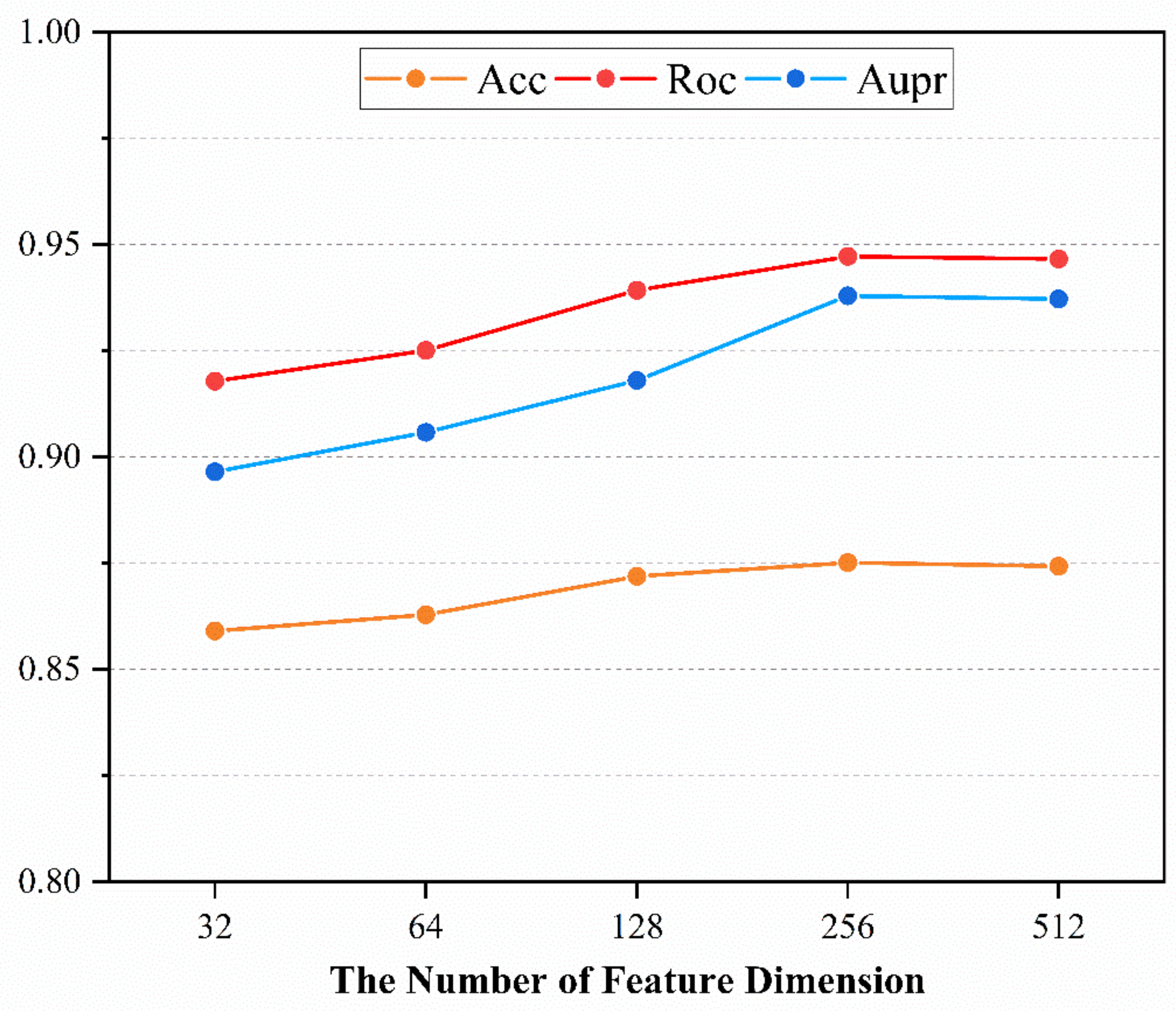
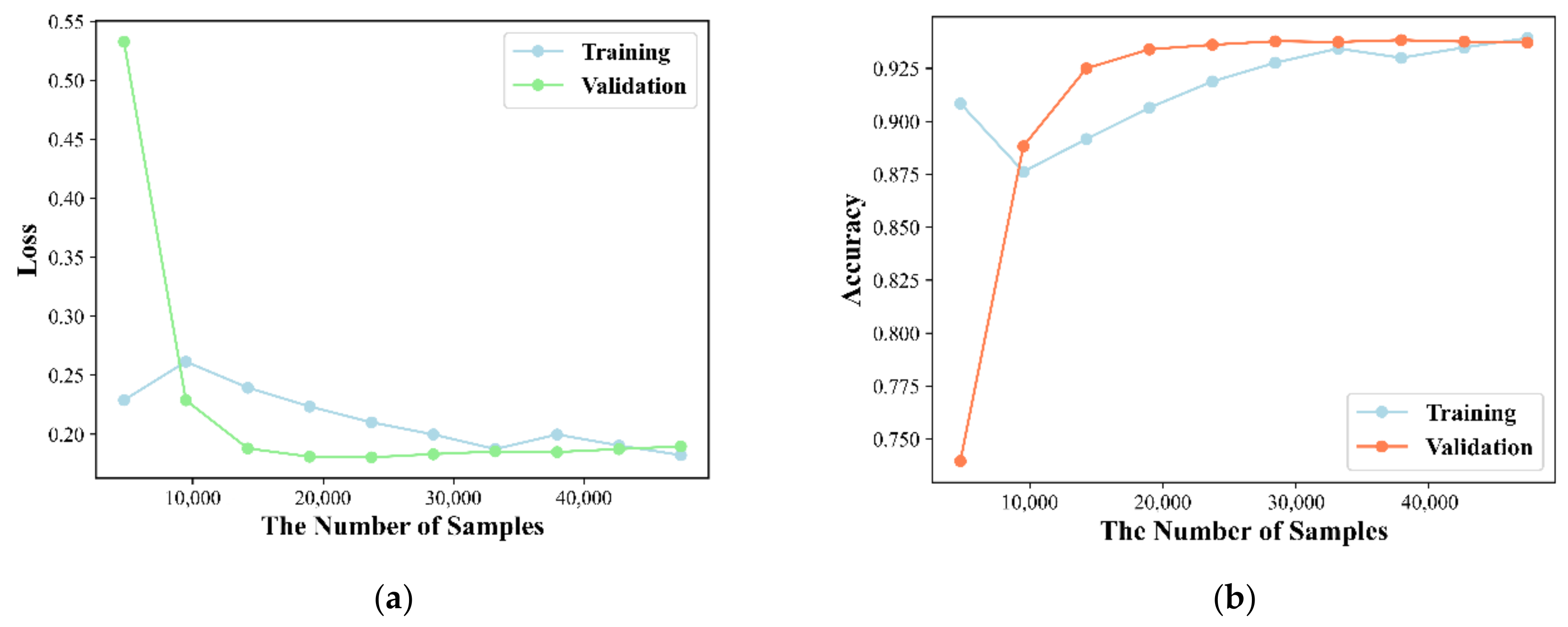
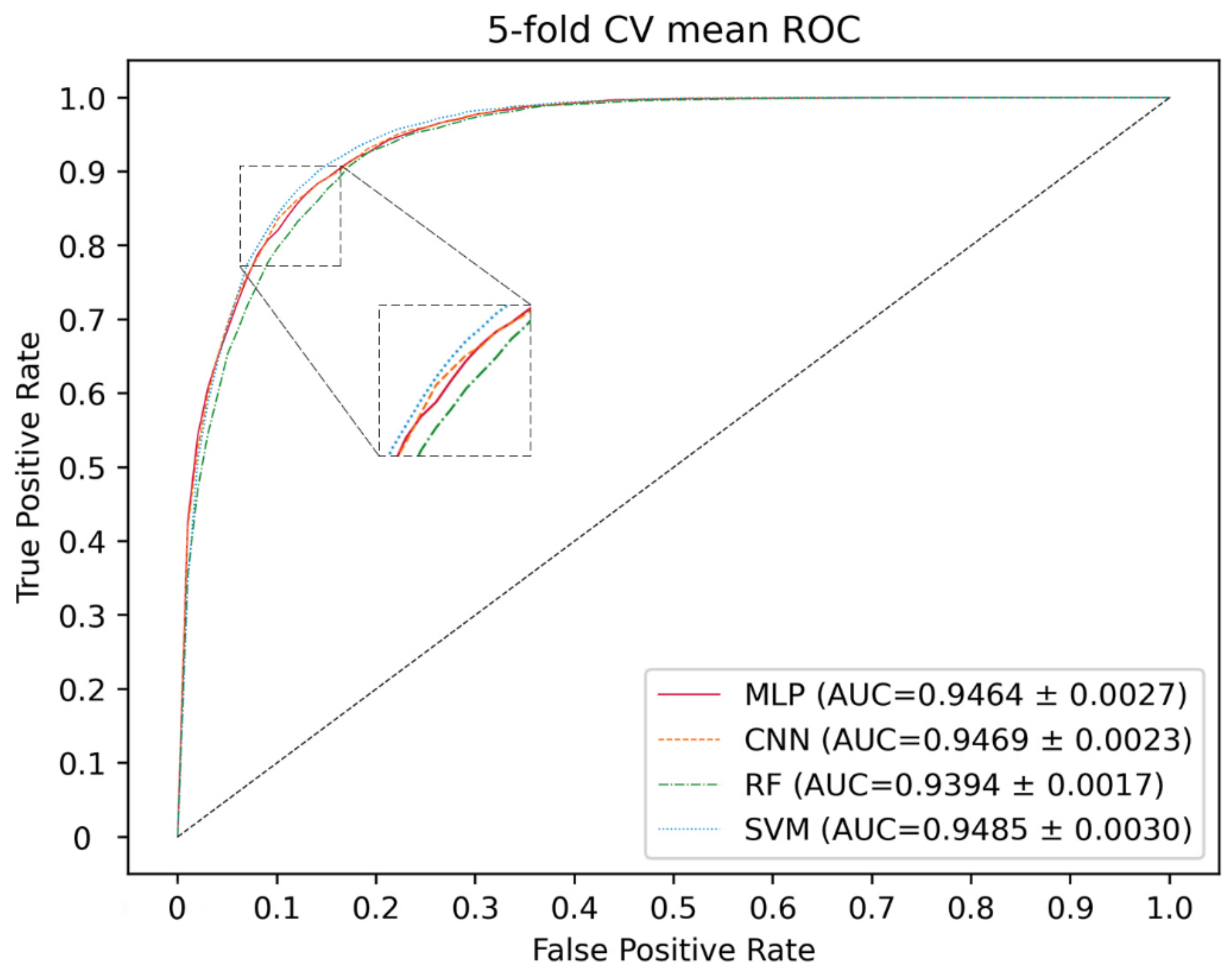
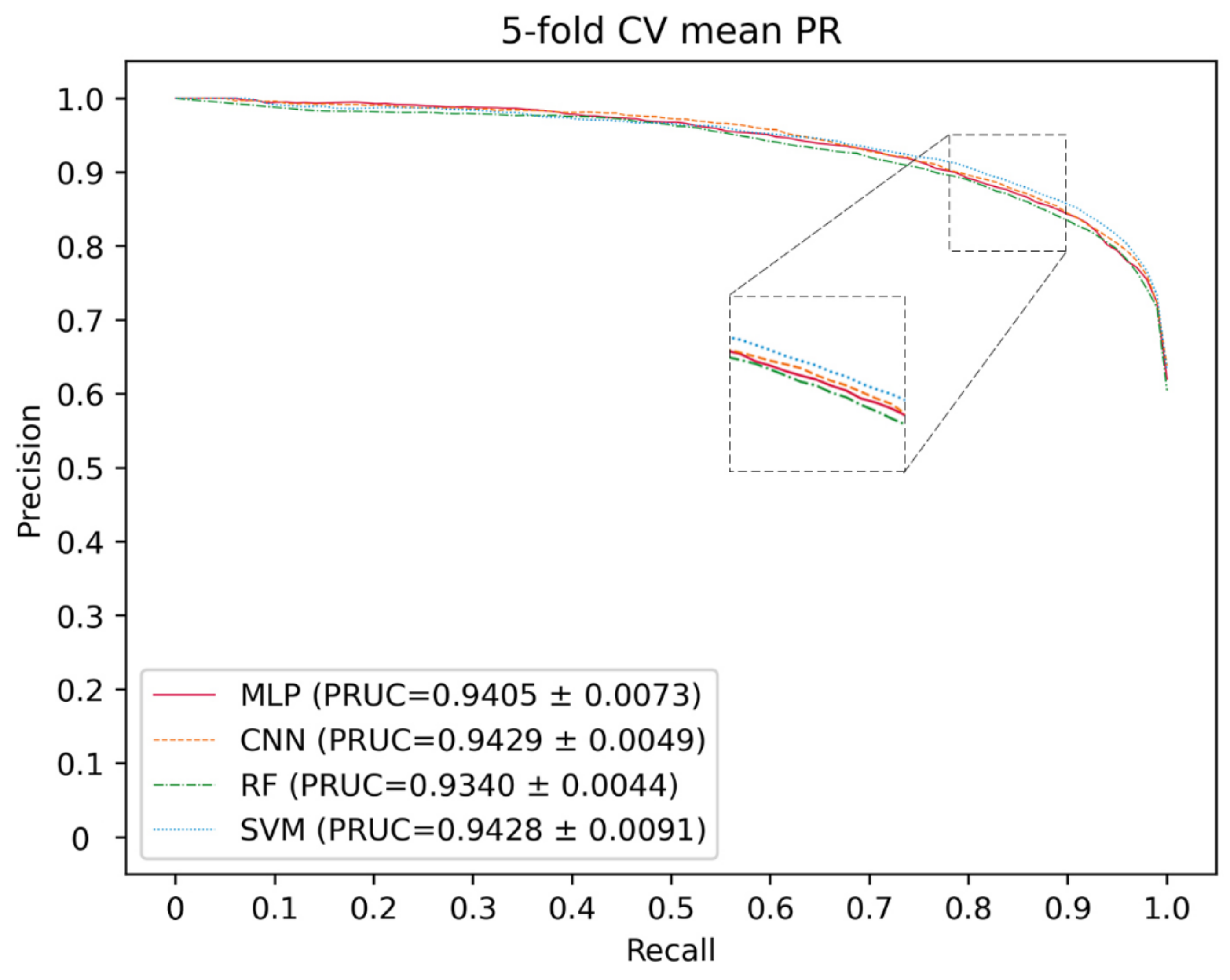

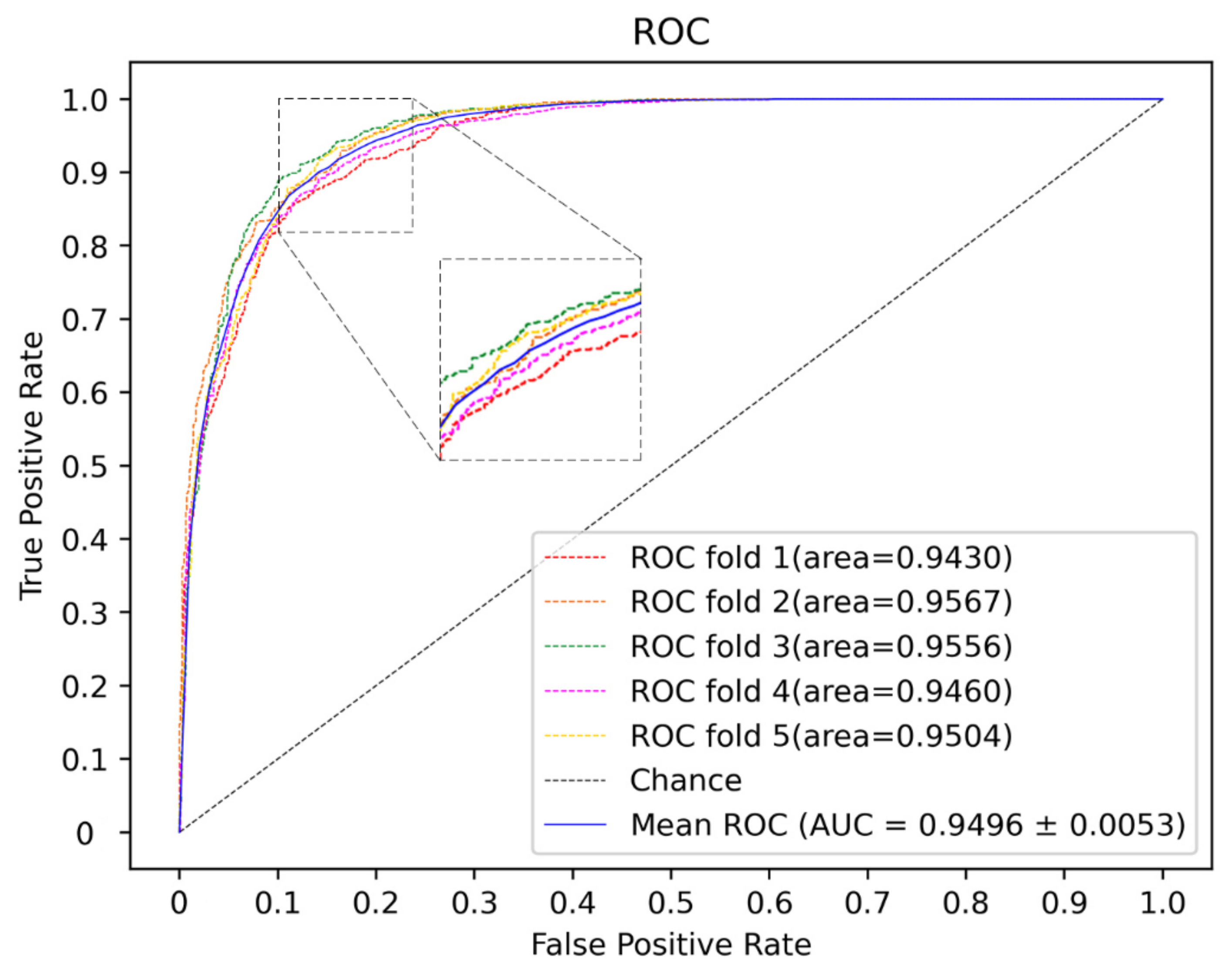
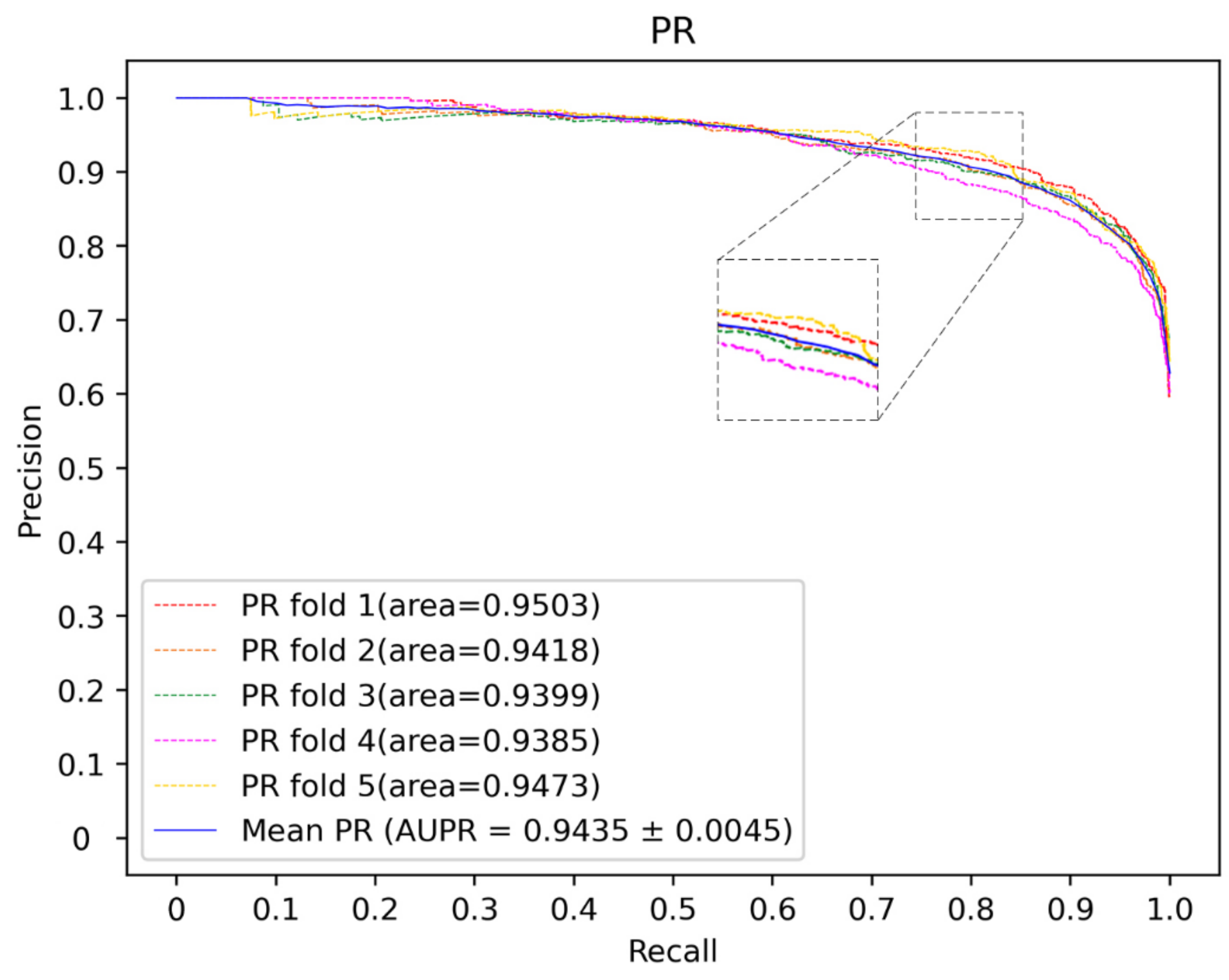
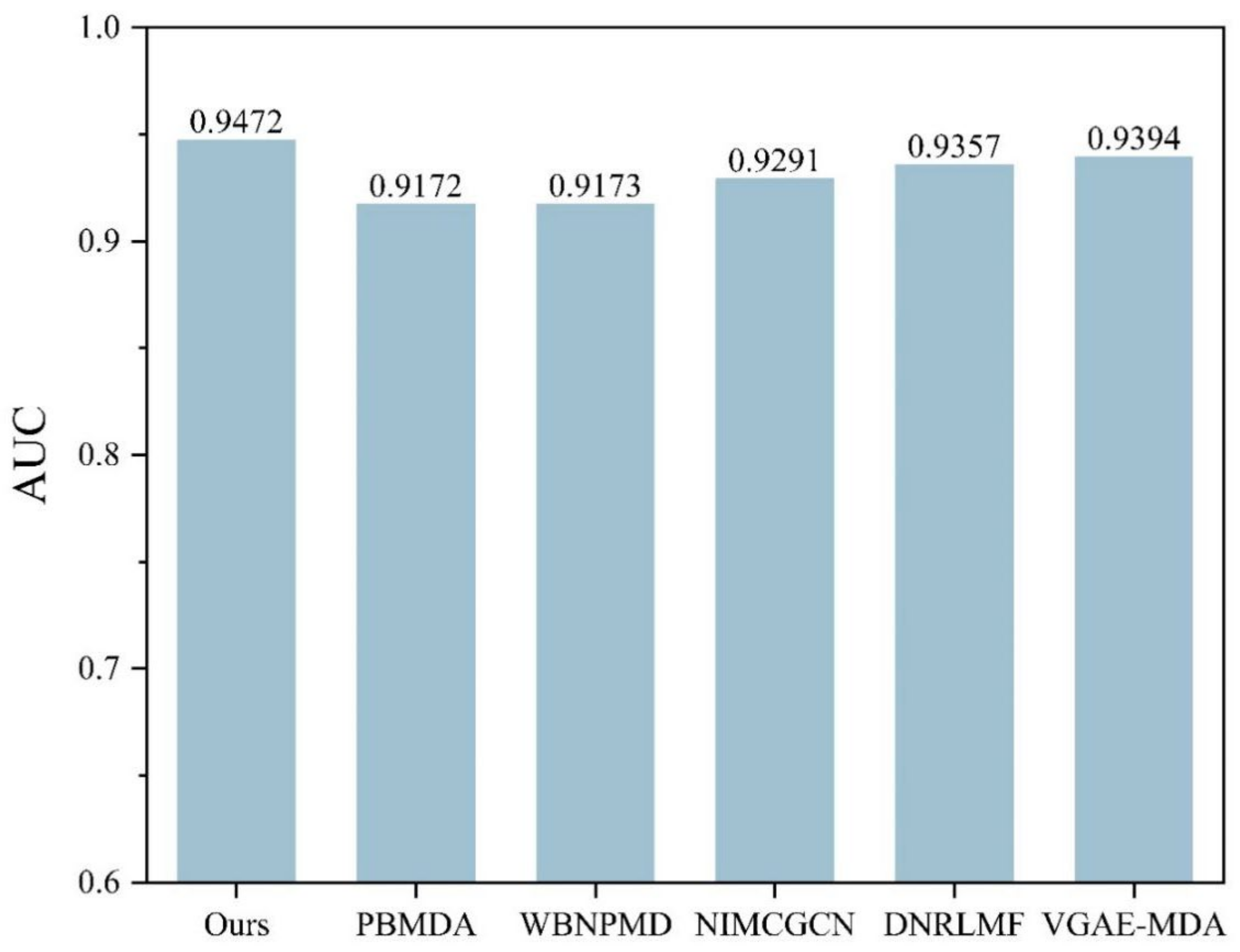



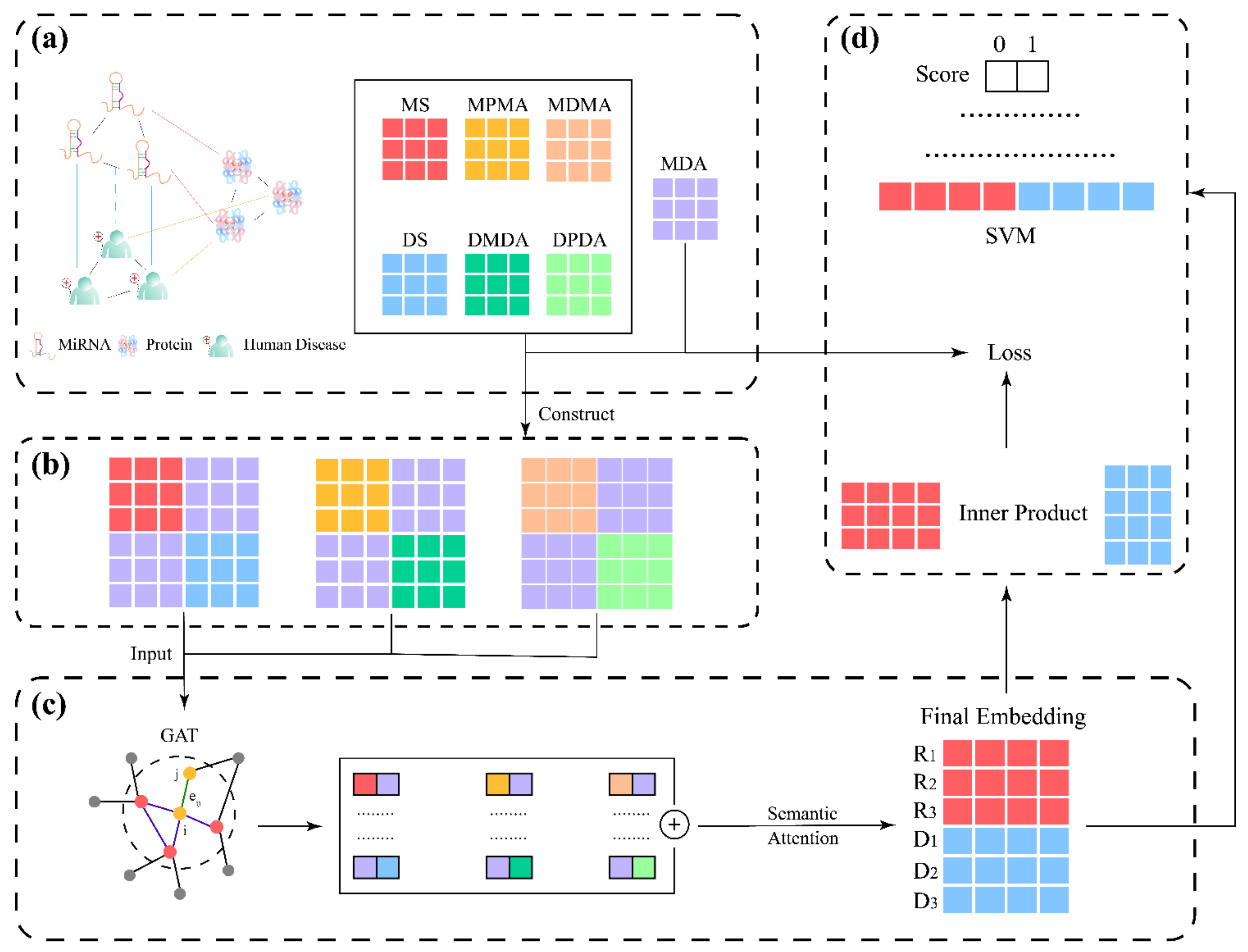
| Acc | Auc | Aupr | Sens | Spec | Prec | F1 | Mcc | |
|---|---|---|---|---|---|---|---|---|
| MLP | 0.8661 | 0.9460 | 0.9420 | 0.8924 | 0.8398 | 0.8504 | 0.8693 | 0.7364 |
| CNN | 0.8689 | 0.9458 | 0.9411 | 0.8984 | 0.8393 | 0.8490 | 0.8725 | 0.7399 |
| RF | 0.8639 | 0.9398 | 0.9327 | 0.8776 | 0.8502 | 0.8542 | 0.8657 | 0.7281 |
| SVM | 0.8752 | 0.9470 | 0.9374 | 0.9156 | 0.83491 | 0.8473 | 0.8801 | 0.7531 |
| Ratio | Acc | Auc | Aupr | Sens | Spec | Prec | F1 | Mcc |
|---|---|---|---|---|---|---|---|---|
| 1:1 | 0.8753 | 0.9470 | 0.9375 | 0.9157 | 0.8349 | 0.8473 | 0.8801 | 0.7531 |
| 1:2 | 0.8790 | 0.9481 | 0.8989 | 0.8168 | 0.9101 | 0.8199 | 0.8182 | 0.7277 |
| 1:3 | 0.8901 | 0.9460 | 0.8634 | 0.7210 | 0.9464 | 0.8177 | 0.7662 | 0.6971 |
| 1:4 | 0.9002 | 0.9422 | 0.8321 | 0.6461 | 0.9637 | 0.8167 | 0.7213 | 0.6684 |
| 1:5 | 0.9098 | 0.9325 | 0.7984 | 0.5898 | 0.9738 | 0.8186 | 0.6854 | 0.6461 |
| Rank | Score | miRNA | Evidence |
|---|---|---|---|
| 1 | 0.9557 | hsa-miR-21 | HMDD3.0, dbDEMC, PMID: 31037150 |
| 2 | 0.9540 | hsa-miR-155 | dbDEMC, PMID: 29565484 |
| 3 | 0.9477 | hsa-miR-146a | HMDD3.0, dbDEMC, PMID: 29133238 |
| 4 | 0.9345 | hsa-miR-29a | HMDD3.0, dbDEMC, PMID: 33891266 |
| 5 | 0.9326 | hsa-miR-16 | HMDD3.0, dbDEMC, PMID: 30657555 |
| 6 | 0.9323 | hsa-miR-29b | dbDEMC, PMID: 34184070 |
| 7 | 0.9309 | hsa-miR-125b | HMDD3.0 dbDEMC, PMID: 32609900 |
| 8 | 0.9301 | hsa-miR-15a | dbDEMC, PMID: 31099097 |
| 9 | 0.9266 | hsa-miR-1 | dbDEMC, PMID: 31846694 |
| 10 | 0.9242 | hsa-miR-221 | HMDD3.0, dbDEMC, PMID: 31069760 |
| 11 | 0.9220 | hsa-miR-34a | HMDD3.0, dbDEMC, PMID: 32778238 |
| 12 | 0.9203 | hsa-miR-17 | dbDEMC, PMID: 32206115 |
| 13 | 0.9195 | hsa-miR-20a | dbDEMC, PMID: 32206115 |
| 14 | 0.9184 | hsa-miR-199a | HMDD3.0, dbDEMC, PMID: 31144384 |
| 15 | 0.9183 | hsa-miR-133a | dbDEMC, PMID: 30086463 |
| 16 | 0.9150 | hsa-miR-19b | dbDEMC, PMID: 29889802 |
| 17 | 0.9147 | hsa-miR-29c | HMDD3.0 dbDEMC, PMID: 30718452 |
| 18 | 0.9141 | hsa-miR-223 | HMDD3.0, dbDEMC, PMID: 32233593 |
| 19 | 0.9139 | hsa-miR-222 | HMDD3.0, dbDEMC, PMID: 34273068 |
| 20 | 0.9101 | hsa-miR-150 | dbDEMC, PMID: 25549355 |
| 21 | 0.9043 | hsa-miR-92a | dbDEMC, PMID: 32587378 |
| 22 | 0.9040 | hsa-miR-18a | dbDEMC, PMID: 34221105 |
| 23 | 0.9015 | hsa-miR-145 | dbDEMC, PMID: 29658584 |
| 24 | 0.9011 | hsa-miR-106b | dbDEMC, PMID: 29975452 |
| 25 | 0.9009 | hsa-miR-181a | dbDEMC, PMID: 25058462 |
| 26 | 0.9006 | hsa-miR-19a | dbDEMC, PMID: 27012708 |
| 27 | 0.8999 | hsa-miR-210 | HMDD3.0, dbDEMC, PMID: 27666683 |
| 28 | 0.8978 | hsa-miR-31 | HMDD3.0, dbDEMC, PMID: 25797269 |
| 29 | 0.8957 | hsa-miR-122 | HMDD3.0, dbDEMC, PMID: 25537773 |
| 30 | 0.8941 | hsa-miR-142 | HMDD3.0, dbDEMC, PMID: 30092578 |
| Rank | Score | miRNA | Evidence |
|---|---|---|---|
| 1 | 0.9690 | hsa-miR-21 | HMDD3.0, dbDEMC, PMID: 30736829 |
| 2 | 0.9675 | hsa-miR-155 | HMDD3.0, dbDEMC, PMID:32447486 |
| 3 | 0.9673 | hsa-miR-122 | HMDD3.0, dbDEMC, PMID: 26604787 |
| 4 | 0.9672 | hsa-miR-15a | HMDD3.0, dbDEMC, PMID: 33059020 |
| 5 | 0.9671 | hsa-miR-29a | HMDD3.0, dbDEMC, PMID: 33250420 |
| 6 | 0.9670 | hsa-miR-16 | HMDD3.0, dbDEMC, PMID: 31379227 |
| 7 | 0.9660 | hsa-miR-29b | HMDD3.0, dbDEMC, PMID: 31813135 |
| 8 | 0.9647 | hsa-miR-133a | HMDD3.0, dbDEMC, PMID: 33074595 |
| 9 | 0.9630 | hsa-miR-1 | HMDD3.0, dbDEMC, PMID: 34139980 |
| 10 | 0.9626 | hsa-miR-15b | dbDEMC, PMID: 32220063 |
| 11 | 0.9617 | hsa-miR-199a | HMDD3.0, dbDEMC, PMID: 28363780 |
| 12 | 0.9608 | hsa-miR-146a | HMDD3.0, dbDEMC, PMID: 29127520 |
| 13 | 0.9602 | hsa-miR-29c | HMDD3.0, dbDEMC, PMID: 29512752 |
| 14 | 0.9598 | hsa-miR-26a | HMDD3.0, dbDEMC, PMID: 33407724 |
| 15 | 0.9588 | hsa-miR-126 | HMDD3.0, dbDEMC, PMID: 34107168 |
| 16 | 0.9586 | hsa-miR-192 | HMDD3.0, dbDEMC, PMID: 29571988 |
| 17 | 0.9581 | hsa-miR-30b | HMDD3.0, dbDEMC, PMID: 33779882 |
| 18 | 0.9578 | hsa-miR-106b | dbDEMC, PMID: 34351868 |
| 19 | 0.9575 | hsa-miR-19b | HMDD3.0, dbDEMC, PMID: 29455644 |
| 20 | 0.9569 | hsa-miR-150 | HMDD3.0, dbDEMC, PMID: 24456795 |
| 21 | 0.9575 | hsa-miR-23a | HMDD3.0, dbDEMC, PMID: 28436951 |
| 22 | 0.9567 | hsa-miR-196a | HMDD3.0, dbDEMC, PMID: 33775710 |
| 23 | 0.9561 | hsa-miR-19a | HMDD3.0, dbDEMC, PMID: 28364280 |
| 24 | 0.9558 | hsa-miR-23b | dbDEMC, PMID: 32495614 |
| 25 | 0.9556 | hsa-miR-206 | HMDD3.0, dbDEMC, PMID: 26919096 |
| 26 | 0.9555 | hsa-miR-26b | HMDD3.0, dbDEMC, PMID: 26744864 |
| 27 | 0.9552 | hsa-miR-223 | HMDD3.0, dbDEMC, PMID: 29615147 |
| 28 | 0.9547 | hsa-miR-195 | HMDD3.0, dbDEMC, PMID: 32406336 |
| 29 | 0.9544 | hsa-miR-222 | HMDD3.0, dbDEMC, PMID: 32588752 |
| 30 | 0.9539 | hsa-miR-34a | HMDD3.0, dbDEMC, PMID: 30700696 |
| Rank | Score | miRNA | Evidence |
|---|---|---|---|
| 1 | 0.9819 | hsa-miR-21 | HMDD3.0, dbDEMC, PMID: 32911844 |
| 2 | 0.9804 | hsa-miR-155 | HMDD3.0, dbDEMC, PMID: 33357126 |
| 3 | 0.9723 | hsa-miR-146a | HMDD3.0, dbDEMC, PMID: 32798394 |
| 4 | 0.9643 | hsa-miR-17 | HMDD3.0, dbDEMC, PMID: 35536524 |
| 5 | 0.9632 | hsa-miR-29a | HMDD3.0, dbDEMC, PMID: 31870103 |
| 6 | 0.9631 | hsa-miR-125b | HMDD3.0, dbDEMC, PMID: 27637078 |
| 7 | 0.9630 | hsa-miR-34a | HMDD3.0, dbDEMC, PMID: 27424989 |
| 8 | 0.9629 | hsa-miR-20a | HMDD3.0, dbDEMC, PMID: 34587164 |
| 9 | 0.9622 | hsa-miR-16 | HMDD3.0, dbDEMC, PMID: 28599250 |
| 10 | 0.9606 | hsa-miR-221 | HMDD3.0, dbDEMC, PMID: 29172404 |
| 11 | 0.9605 | hsa-miR-29b | dbDEMC, PMID: 29435107 |
| 12 | 0.9568 | hsa-miR-92a | HMDD3.0, dbDEMC, PMID: 31870103 |
| 13 | 0.9556 | hsa-miR-145 | HMDD3.0, dbDEMC, PMID: 32538049 |
| 14 | 0.9552 | hsa-miR-126 | HMDD3.0, dbDEMC, PMID: 34686664 |
| 15 | 0.9546 | hsa-miR-1 | dbDEMC, PMID: 28042875 |
| 16 | 0.9543 | hsa-miR-15a | HMDD3.0, dbDEMC, PMID: 24026141 |
| 17 | 0.9532 | hsa-miR-19b | HMDD3.0, dbDEMC, PMID: 29032147 |
| 18 | 0.9520 | hsa-miR-18a | HMDD3.0, dbDEMC, PMID: 32146479 |
| 19 | 0.9505 | hsa-let-7a | dbDEMC, PMID: 29398802 |
| 20 | 0.9489 | hsa-miR-19a | HMDD3.0, dbDEMC, PMID: 34895042 |
| 21 | 0.9473 | hsa-miR-222 | HMDD3.0, dbDEMC, PMID: 20203269 |
| 22 | 0.9463 | hsa-miR-143 | dbDEMC, PMID: 28890884 |
| 23 | 0.9454 | hsa-miR-31 | HMDD3.0, dbDEMC, PMID: 22511990 |
| 24 | 0.9453 | hsa-miR-29c | dbDEMC, PMID: 31333331 |
| 25 | 0.9445 | hsa-miR-223 | HMDD3.0, dbDEMC, PMID: 27900032 |
| 26 | 0.9443 | hsa-miR-133a | dbDEMC, PMID: 32647415 |
| 27 | 0.9439 | hsa-miR-199a | HMDD3.0, dbDEMC, PMID: 31636666 |
| 28 | 0.9409 | hsa-let-7b | HMDD3.0, dbDEMC, PMID: 33283713 |
| 29 | 0.9398 | hsa-miR-150 | HMDD3.0, dbDEMC, PMID: 27917123 |
| 30 | 0.9386 | hsa-miR-200b | PMID: 30574752 |
| Method | AUC | Advantages | Drawbacks |
|---|---|---|---|
| PBMDA | 0.9172 | Topological information, complex network | No weighted, imbalance problem |
| WBNPMD | 0.9173 | Weighted edges | No topological information, imbalance problem |
| NIMCGCN | 0.9291 | Topological information, complex network, neural inductive | No weighted, imbalance problem |
| DNRLMF | 0.9357 | Complex network, dynamic regularized weight | No topological information, imbalance problem |
| VGAE-MDA | 0.9394 | Topological information, complex network, variational Bayesian inference | No weighted, imbalance problem |
| Ours | 0.9472 | Topological information, complex network, adaptive weight | Imbalance problem |
| Parameters | |
|---|---|
| GAT | Input (1, 857, 857) |
| Node attention layer (1, 857, 32) 8, activation function | |
| Concatenate layer (1, 857, 256) | |
| Module attention layer (857, 256), activation function | |
| Dense layer (857, 256), activation function | |
| Learning rate (0.001) | |
| Epoch (2000) | |
| SVM | Kernel function (radial basis function) |
| C factor (50) |
Publisher’s Note: MDPI stays neutral with regard to jurisdictional claims in published maps and institutional affiliations. |
© 2022 by the authors. Licensee MDPI, Basel, Switzerland. This article is an open access article distributed under the terms and conditions of the Creative Commons Attribution (CC BY) license (https://creativecommons.org/licenses/by/4.0/).
Share and Cite
Li, Z.; Huang, X.; Shi, Y.; Zou, X.; Li, Z.; Dai, Z. Identification of MiRNA–Disease Associations Based on Information of Multi-Module and Meta-Path. Molecules 2022, 27, 4443. https://doi.org/10.3390/molecules27144443
Li Z, Huang X, Shi Y, Zou X, Li Z, Dai Z. Identification of MiRNA–Disease Associations Based on Information of Multi-Module and Meta-Path. Molecules. 2022; 27(14):4443. https://doi.org/10.3390/molecules27144443
Chicago/Turabian StyleLi, Zihao, Xing Huang, Yakun Shi, Xiaoyong Zou, Zhanchao Li, and Zong Dai. 2022. "Identification of MiRNA–Disease Associations Based on Information of Multi-Module and Meta-Path" Molecules 27, no. 14: 4443. https://doi.org/10.3390/molecules27144443
APA StyleLi, Z., Huang, X., Shi, Y., Zou, X., Li, Z., & Dai, Z. (2022). Identification of MiRNA–Disease Associations Based on Information of Multi-Module and Meta-Path. Molecules, 27(14), 4443. https://doi.org/10.3390/molecules27144443







